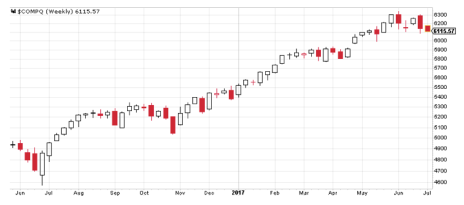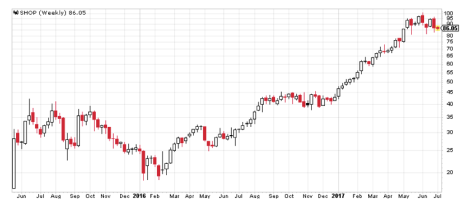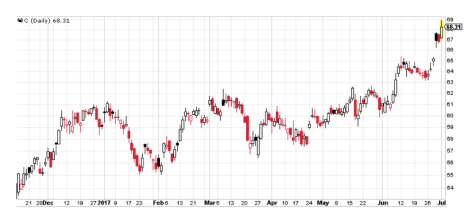Sector rotation is always big news among growth investors for a couple of reasons. First, growth investors actively pursue opportunities in hot sectors, buying growth stock leaders that are supported by larger trends.
One of the biggest such trends of the market’s recent bull move was the strength of tech stocks. It’s easy to see in this chart of the tech-heavy Nasdaq’s performance from June 2016 through May 2017.
This big advance by the Nasdaq followed a six-month correction from July 2015 to January 2016 that drove many tech investors to the sidelines. That kind of correction often creates opportunities for growth investors who keep their eyes open for shifts in sentiment.
[text_ad]
Another reason for the importance of shifting preferences is that money that starts chasing a new herd of stocks must necessarily come out of the old herd. And growth investors who have enjoyed the great performance of stocks that have been boosted by their sector can sometimes be reluctant to take their profits and move on to the next big thing.
It takes a fair amount of discipline to let go of a big winner that has begun to crumble, but that’s one of the primary skills that a growth investor needs. Sentimental attachment is an expensive luxury for investors who look for big moves in stocks with momentum.
For instance, here’s a weekly chart for Shopify (SHOP), one of the big winners in the tech rally. Shopify provided investors with an attractive story based on the continuing trend of more and more merchants setting up shop online, a move that Shopify made easy. The company’s four years of revenue growth of 90% or more gave the story a solid fundamental base and the prospect of Shopify turning profitable in 2018 was an additional sweetener.
Looking at this kind of chart, with its big rebound from a 2015 correction and the rally that strengthens in July 2016 when the tech sector revs up, makes it hard to judge the stock’s performance over the past nine weeks. The stock’s action doesn’t look much worse than its pause from August through December 2016. But SHOP is now 14% off its June high at 100, and has had some volume spikes on selling days.
Is the tech rally really over? Is the move into financials really the next big thing? It’s hard to see bank stocks—heavily followed by analysts and low on innovation and surprises—going on an extended run.
But growth investing requires that you take seriously what shows up in the charts. And this daily chart of what’s happening with Citigroup (C) makes a strong case for the stock’s changing reputation with growth investors.
Keeping an eye on broader market trends can pay off for growth investors. And Cabot’s growth advisories, like Cabot Growth Investor can keep you up to date on what’s happening and what you should do about it.
[author_ad]



